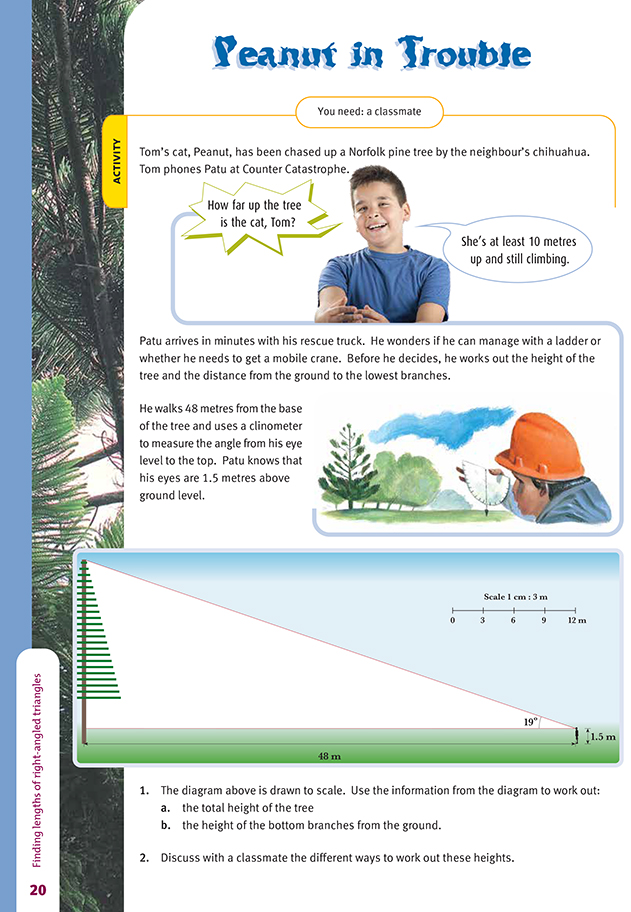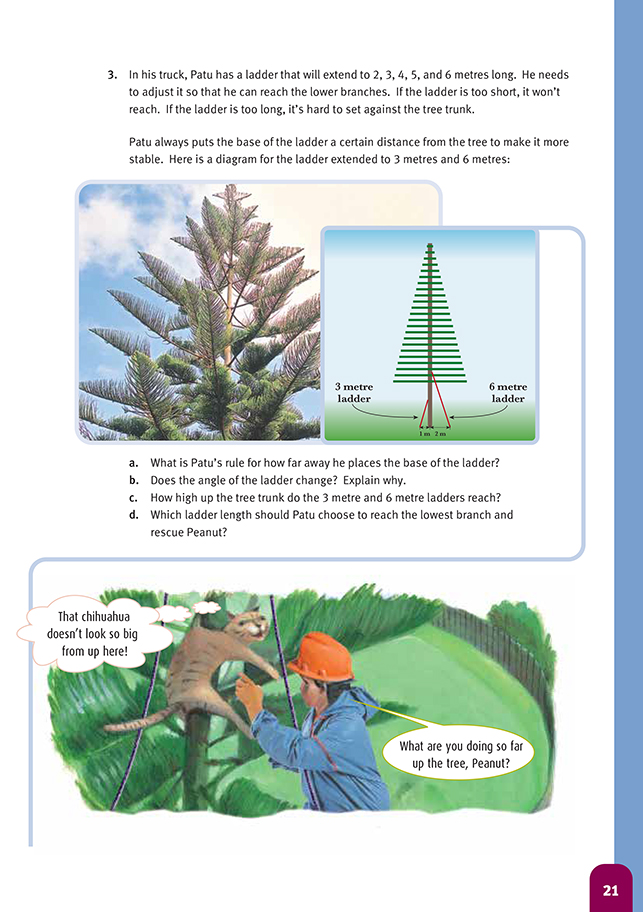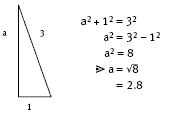This is a level 5 geometry activity from the Figure It Out theme series.
A PDF of the student activity is included.
Click on the image to enlarge it. Click again to close. Download PDF (282 KB)
solve problems using trigonometry
solve problesm using Pythagoras
FIO, Levels 4-4+, Theme: Disasters Strike!, Peanut in Trouble, pages 20-21
A classmate
Other mathematical ideas and processes
Students will also:
• work with scale drawings
• use ratio to find unknown elements in similar triangles.
Activity
Although this problem can be solved using trigonometric ratios, these are not introduced until level 5 of the curriculum and are best avoided unless you have some very able students.
The best approach is to use the fact that the drawing supplied is to scale. The students will need to discover for themselves what the scale is by measuring and comparing the only length they are given (48 metres from Patu to the base of the tree) with its scale length, 16 centimetres. They will see that 1 centimetre on the
diagram represents 3 metres in real life. It is a short step from here to determining that, if the height of the tree in the diagram is 6 centimetres, the height of the tree in real life must be 6 x 3 = 18 metres. The bottom branches in the diagram are 1.5 centimetres from the ground, or 1.5 x 3 = 4.5 metres in reality. The fact that
the angle of inclination is 19 degrees plays no part in solving the problem using scale.
Questions 2 and 3 invite exploration of similar triangles (triangles that are the same shape but a different size) and the way in which pairs of corresponding sides have the same ratio.
For example:
If A =P, B= Q, C = R, then
A scale diagram to help with questions 3c and d is provided in the Answers. You could also use these questions to introduce more able students to Pythagoras’ theorem:
In this case, they need to find a, so for the 3 metre ladder:
Answers to Activity
1. a. The tree is 18 m tall.
This could be found by using the scale of the diagram, 1 cm : 3 m, and measuring accurately. Alternatively, you could compare the height of the tree to the distance of 48 m. You may be advanced enough to use trigonometry to solve the problem:
Adding the height from the ground to Patu’s eyes gives 16.5 + 1.5 = 18 m.
b. Using the scale 1 cm : 3 m gives 4.5 m above ground level. Alternatively, the lower branches are about one-quarter of the way up the trunk. 1/4 of 18 is 4.5, so the branches are 4.5 m above ground level.
2. Discussion will vary.
3. a. Patu places the base of the ladder one-third of the height of the ladder away from the tree, for example, 1/3 x 3 m = 1 m and 1/3 x 6 m = 2 m.
b. The angle remains unchanged (at about 70.5°) because, although the size of the triangle changes, the shape doesn’t.
c. The 3 m ladder reaches about 2.8 m up the trunk.
The 6 m ladder reaches about 5.7 m up the trunk.
A scale diagram using a scale of 1 cm : 1 m will have these measurements:
If you used Pythagoras’ theorem, your working could look like this:
d. The 4 m ladder reaches about 3.8 m up the trunk, and the 5 m ladder reaches about 4.7 m up the trunk. The 5 m ladder is best.








